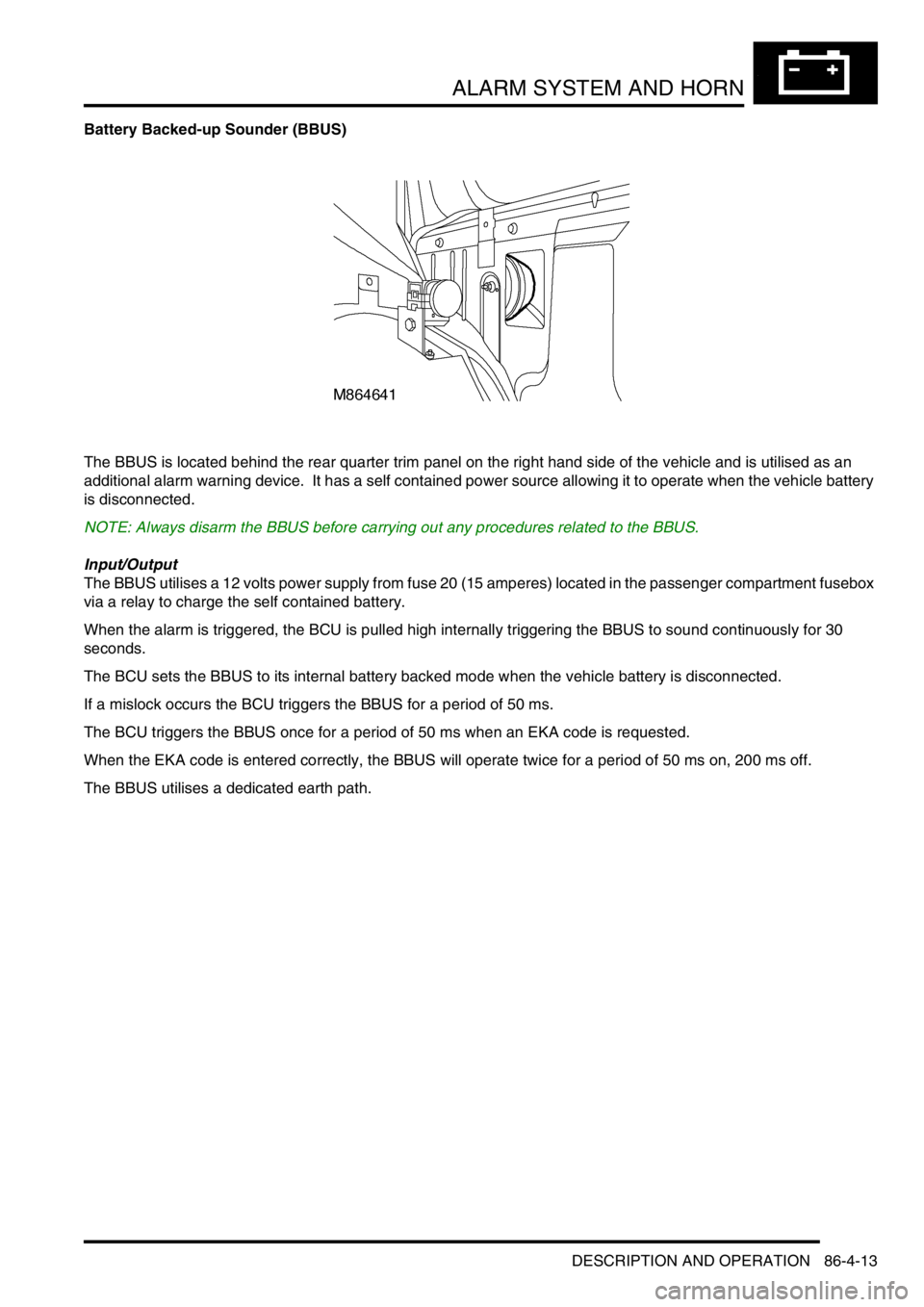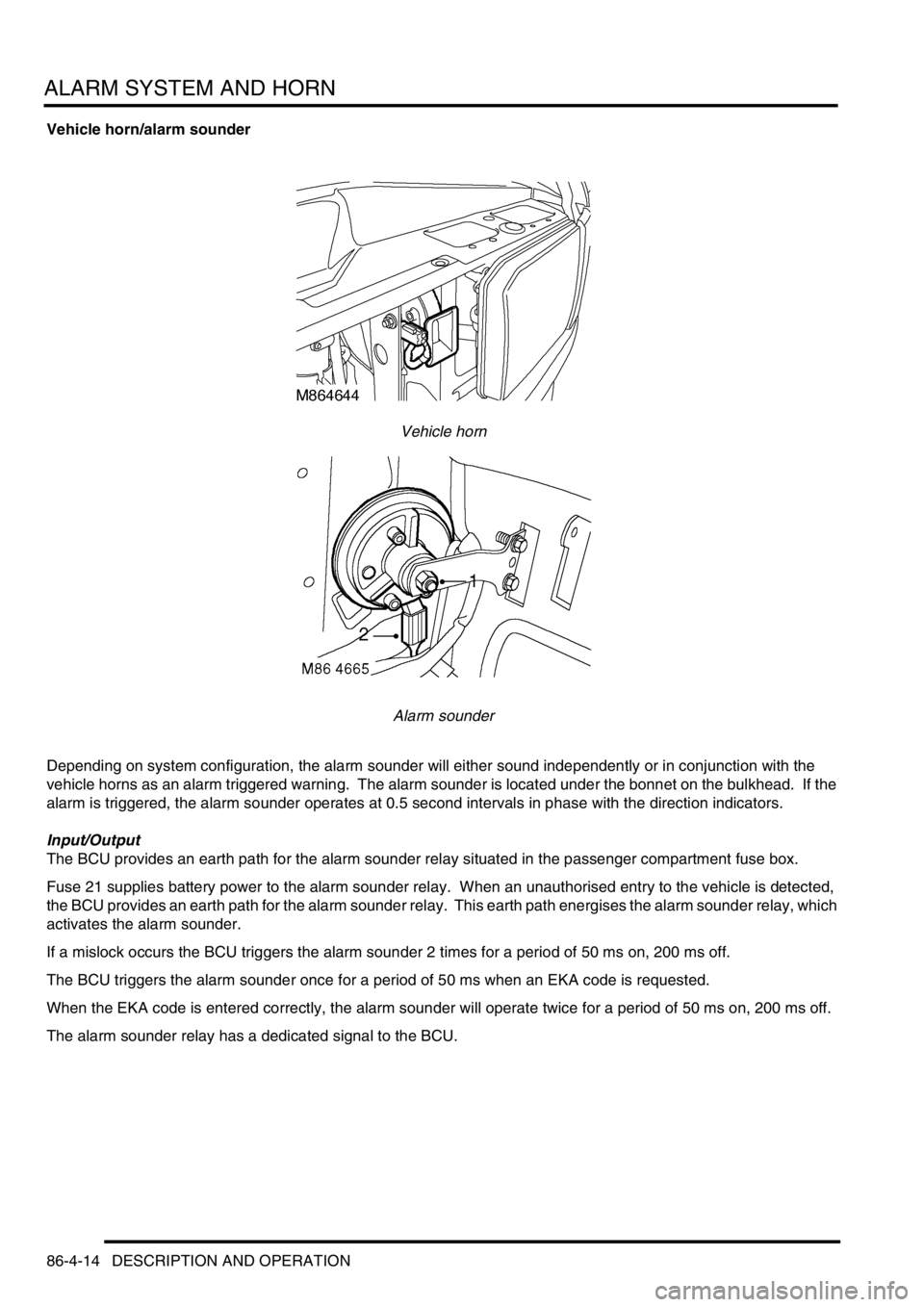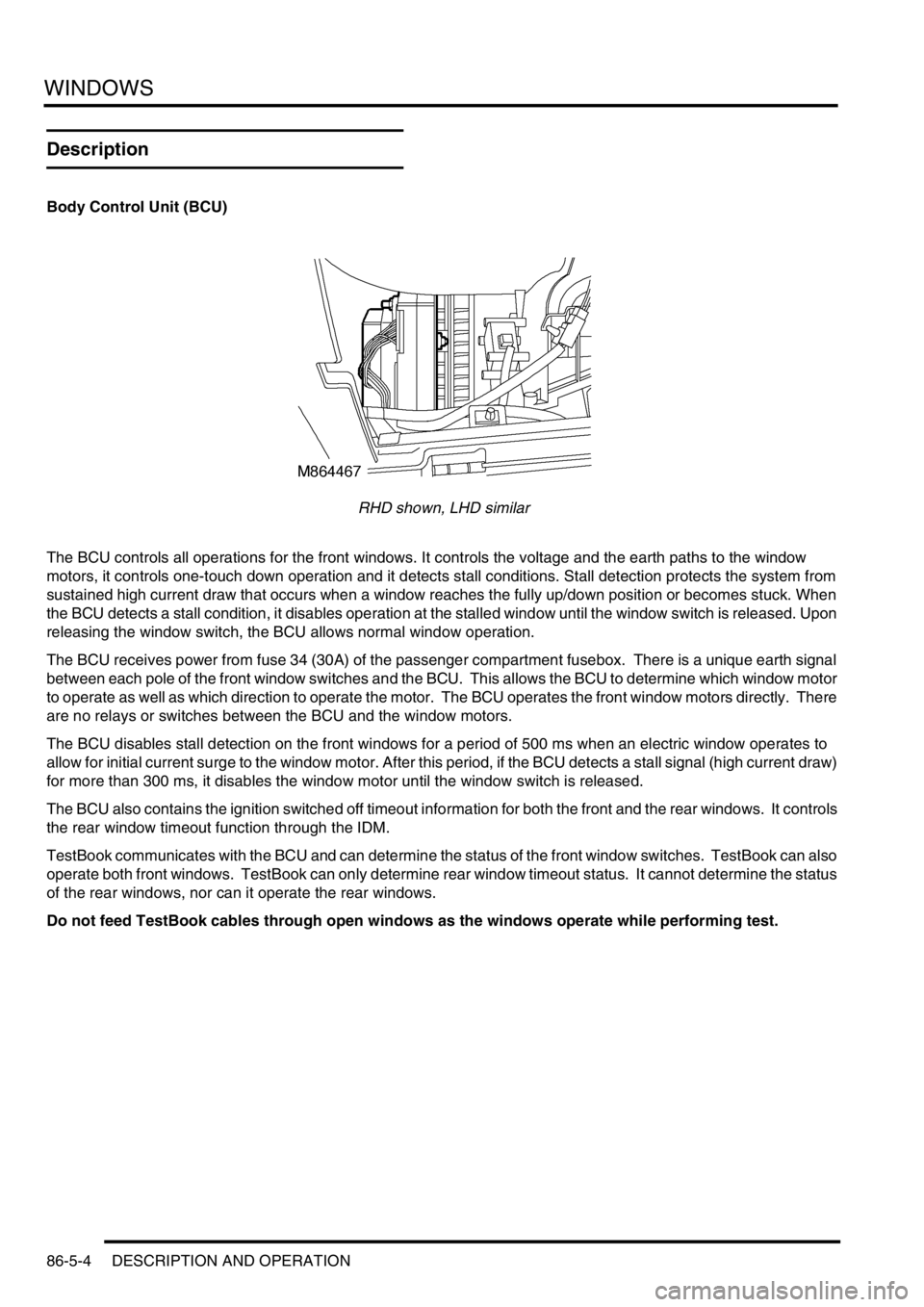Page 1521 of 1672
ALARM SYSTEM AND HORN
86-4-12 DESCRIPTION AND OPERATION
Passive remobilisation exciter coil
The passive remobilisation exciter coil consists of a coil around the steering column lock. The coil energises to create
a magnetic field when the ignition is switched to position II.
This coil activates the handset initiating the mobilisation of the vehicle.
Input/Output
The input to the passive remobilisation exciter coil from the BCU is a 12 volts 125 kHz sinewave. The passive
remobilisation exciter coil also receives an ignition controlled power supply via fuse 20 (15 amperes) located in the
engine compartment fuse box. On receiving these signals, a magnetic field is generated which activates the handset
to produce a remobilisation signal. This remobilisation signal is transmitted to the remote receiver and onto the BCU
to allow the engine to start.
Page 1522 of 1672

ALARM SYSTEM AND HORN
DESCRIPTION AND OPERATION 86-4-13
Battery Backed-up Sounder (BBUS)
The BBUS is located behind the rear quarter trim panel on the right hand side of the vehicle and is utilised as an
additional alarm warning device. It has a self contained power source allowing it to operate when the vehicle battery
is disconnected.
NOTE: Always disarm the BBUS before carrying out any procedures related to the BBUS.
Input/Output
The BBUS utilises a 12 volts power supply from fuse 20 (15 amperes) located in the passenger compartment fusebox
via a relay to charge the self contained battery.
When the alarm is triggered, the BCU is pulled high internally triggering the BBUS to sound continuously for 30
seconds.
The BCU sets the BBUS to its internal battery backed mode when the vehicle battery is disconnected.
If a mislock occurs the BCU triggers the BBUS for a period of 50 ms.
The BCU triggers the BBUS once for a period of 50 ms when an EKA code is requested.
When the EKA code is entered correctly, the BBUS will operate twice for a period of 50 ms on, 200 ms off.
The BBUS utilises a dedicated earth path.
Page 1523 of 1672

ALARM SYSTEM AND HORN
86-4-14 DESCRIPTION AND OPERATION
Vehicle horn/alarm sounder
Vehicle horn
Alarm sounder
Depending on system configuration, the alarm sounder will either sound independently or in conjunction with the
vehicle horns as an alarm triggered warning. The alarm sounder is located under the bonnet on the bulkhead. If the
alarm is triggered, the alarm sounder operates at 0.5 second intervals in phase with the direction indicators.
Input/Output
The BCU provides an earth path for the alarm sounder relay situated in the passenger compartment fuse box.
Fuse 21 supplies battery power to the alarm sounder relay. When an unauthorised entry to the vehicle is detected,
the BCU provides an earth path for the alarm sounder relay. This earth path energises the alarm sounder relay, which
activates the alarm sounder.
If a mislock occurs the BCU triggers the alarm sounder 2 times for a period of 50 ms on, 200 ms off.
The BCU triggers the alarm sounder once for a period of 50 ms when an EKA code is requested.
When the EKA code is entered correctly, the alarm sounder will operate twice for a period of 50 ms on, 200 ms off.
The alarm sounder relay has a dedicated signal to the BCU.
Page 1540 of 1672
WINDOWS
DESCRIPTION AND OPERATION 86-5-1
WINDOWS DESCRIPTION AND OPERAT ION
Electric windows block diagram
1Passenger compartment fusebox
2BCU
3LH front window switch
4LH front window motor
5RH front window switch
6RH front window motor
7Rear window lift relay8Centre console LH rear window switch
9LH rear door window switch
10LH rear door window motor
11Centre console RH rear window switch
12RH rear door window switch
13RH rear door window motor
14Rear window isolation switch
Page 1542 of 1672
WINDOWS
DESCRIPTION AND OPERATION 86-5-3
1Passenger compartment fusebox
2Body Control Unit (BCU)
3LH front window switch
4LH front window motor
5RH front window switch
6RH front window motor
7Rear window lift relay
8Centre console LH rear window switch
9LH rear door window switch
10LH rear door window motor
11Centre console RH rear window switch
12RH rear door window switch
13RH rear door window motor
14Rear window isolation switch
Page 1543 of 1672

WINDOWS
86-5-4 DESCRIPTION AND OPERATION
Description
Body Control Unit (BCU)
RHD shown, LHD similar
The BCU controls all operations for the front windows. It controls the voltage and the earth paths to the window
motors, it controls one-touch down operation and it detects stall conditions. Stall detection protects the system from
sustained high current draw that occurs when a window reaches the fully up/down position or becomes stuck. When
the BCU detects a stall condition, it disables operation at the stalled window until the window switch is released. Upon
releasing the window switch, the BCU allows normal window operation.
The BCU receives power from fuse 34 (30A) of the passenger compartment fusebox. There is a unique earth signal
between each pole of the front window switches and the BCU. This allows the BCU to determine which window motor
to operate as well as which direction to operate the motor. The BCU operates the front window motors directly. There
are no relays or switches between the BCU and the window motors.
The BCU disables stall detection on the front windows for a period of 500 ms when an electric window operates to
allow for initial current surge to the window motor. After this period, if the BCU detects a stall signal (high current draw)
for more than 300 ms, it disables the window motor until the window switch is released.
The BCU also contains the ignition switched off timeout information for both the front and the rear windows. It controls
the rear window timeout function through the IDM.
TestBook communicates with the BCU and can determine the status of the front window switches. TestBook can also
operate both front windows. TestBook can only determine rear window timeout status. It cannot determine the status
of the rear windows, nor can it operate the rear windows.
Do not feed TestBook cables through open windows as the windows operate while performing test.
Page 1546 of 1672
WINDOWS
DESCRIPTION AND OPERATION 86-5-7
Rear window lift relay
The rear window lift relay is a normally open relay that provides power to the rear window system. It is controlled by
the IDM. The IDM receives a rear window enable signal from the BCU to allow operation during the ignition switched-
off timeout period.
Both the rear window lift relay and the IDM are located in the passenger compartment fusebox. The IDM is integral
to the passenger compartment fusebox.
The rear window lift relay receives voltage from fuse 13 (30A) in the passenger compartment fusebox. The IDM
controls the earth side of the relay coil.
TestBook cannot monitor the status of the rear window lift relay.
Page 1547 of 1672

WINDOWS
86-5-8 DESCRIPTION AND OPERATION
Rear window switches
There are two sets of switches that operate the rear windows. There is a set of rear window switches located in the
centre console that allow the front seat occupants to operate the rear windows. The second set of switches are
located on the rear doors. All rear window switches are non-latching rocker switches.
A conventional window switch circuit controls the rear window system. In the rest position, there is battery voltage at
both sides of every switch as well as at the window motors. Operating any switch provides a ground path through the
switch to the window motor. Operating the switch in the opposite direction switches the voltage path and the earth
path to the motor allowing the motor to run in the opposite direction.
Voltage for the rear windows is from fuse 13 (30A) in the passenger compartment fusebox through the rear window
lift relay to the switches and motors.
TestBook cannot monitor the status of the rear window switches.